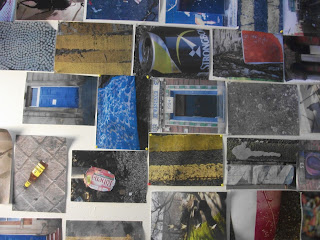My expectations at the beginning of this project was too just create a variety of samples that related to my chosen words of singular and repetition. As I started my project I did have a lot of samples but some of them were just experimental and didn't really relate to my chosen words but did influence colour choice or other elements.
My experimental skills have definately improved in this project, I've used a variety of techniques and played around with them creating different combinations. The techniques I used were:- Gathering, Suffolk Puffs, Shibori, Starch resist, dyeing and Indigo dyeing, I also used the heat press and experimented with different resist techniques using pegs, clips, elastic bands and clamps. I found the sampling part of this project was time too just be experimental.
Choosing the dye workshop was really all about being able to work with colour and to be able to apply colour without the samples looking tacky. I didn't stick to a certain material I explored this area too by using a varity of materials including:- scrim, cotton, calico etc.
Cancelling down to certain materials and techniques was challenging for me because I think I used such a large range that choosing one that was better than the others was difficult. I narrowed down to using printed bricks because I think that it fitted in really well with my chosen words and architecture in which I was looking at.My sketchbook became like a photofile of all my samples, using my sketchbook gave me the areas to reflect on each sample. I think using a sketchbook is a good way of presenting my ideas in a thoughtful process which is clear, I hope.
Using media's and materials in this project became an aspect of my ideas, each sample used different materials to show changes in the quality of the material. I dyed some materials in the same dye vat just to see which material took to the dye better. I found this project very experimental because it required samples and I did this to the best of my ability.
I have definately preferred this project to my last because my ideas were more continous but making decisions seemed more challenging on this one because there was a lot more to chose from. My ideas chose themselves, I tend to go with the ideas I feel more comfortable in and the ones I think have worked better than others. I developed samples which turned out well but needed pushing further- this I applied to my indigo samples.
If I was too start the project again I think I would have took a lot more specific photos that would have linked into my samples alot more. I would have also narrowed down the amount of samples so it wouldn't be so confusing and difficult to highlight the appropriate/better ideas.
I would have definately explored more artists in my research. The bits I did I find really helped (the hanging suffolk puff experiment influenced by Susie Macmurrays work).
During this project I've realised that experimenting in areas that don't always relate can still be useful in some ways whether it is just the colour. I have also learn't that some experiments that don't work lead onto the ideas that do work.
Looking at other people's work theres always something you find that interests you, that can also relate to your work. Some people in my dye workshop have worked a lot smaller than me and there work is so precise where as mine was more experimental and is all about sampling and producing samples that I find relevant and interesting. What surprised me from my work to other peoples work out of my class was the colour difference, my colours were really vibrant yet worked for me but otheres was neutral or either indigo like some of mine were too.



















































